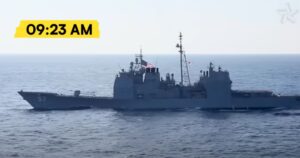The Spark That Nearly Lit the Fuse: A Morning in the South China Sea
June 14th, 2025. The USS Princeton, a steel titan of American resolve, sliced through the South China Sea under a sky so blue it hurt your eyes. At 0923 hours, her SPY radar painted a blip on the horizon—an old foe, a Chinese Type 052D destroyer, Jon Chong, lurking at 200 kilometers. Suddenly, the Chinese ship surged from 18 to 30 knots. It wasn’t a routine patrol anymore. It was a high-stakes chess match.
Unknown to the Americans, Jon Chong’s captain had just received a message from Beijing: “Intercept the Americans. Make them blink first.” But Beijing was about to discover why poking the US Navy in open water is the diplomatic equivalent of juggling live grenades.
The Calm Before the Storm
The Nimitz carrier strike group, the pride of American steel and tradition, had been doing what US sailors have done for generations—keeping the world’s most vital sea lanes open. These waters weren’t just blue—they were gold, with $3.4 trillion of annual trade flowing like blood through the world’s economy. The Americans were 180 nautical miles from the nearest Chinese territory, deep in international waters, where professionalism separates navies from pirates.
At 0926, the Princeton’s radar operators confirmed the threat. Inside the Combat Information Center, the tactical action officer watched the Chinese destroyer’s vector with the calm of a man who knows he’s holding 122 vertical launch cells—enough firepower to turn any Chinese ship into a cautionary tale.
The Chinese destroyer was closing fast. Her YJ-18 anti-ship missiles could reach the Princeton in under four minutes once launched. But the Princeton’s SM-6s could reach out even further and swat them out of the sky. It was a deadly dance—one misstep, and the South China Sea would turn red.

Confidence, Not Panic
At 0929, the captain asked, “Intent?” The answer: “Weapons release range in 14 minutes.” The recommendation: “Go to general quarters.” The captain’s response was pure American swagger: “Let’s see how badly they want to embarrass themselves first.”
Merchant ships dotted the sea—Singaporean containers loaded with semiconductors, Korean LNG tankers worth $200 million. All depended on the US Navy’s presence. If Beijing wanted to turn international waters into its own pool, it would have to win a fight it had never won before.
At 0930, the Princeton’s threat data zipped across the strike group. The Nimitz herself—104,600 tons of diplomacy, 90 aircraft onboard—adjusted flight ops with the precision of a Swiss watch. Destroyers Chung Hun and Kidd shifted into position, ready to turn any Chinese attack into a one-way trip to the bottom.
All In, All Outclassed
At 0935, the E2-D Hawkeye, orbiting at 25,000 feet, spotted multiple J-15 fighters launching from the Chinese carrier Shandong. The J-15s clawed for altitude, burning fuel at a rate that would make any pilot wince. The Hawkeye’s operators chuckled—ski jump launches meant the Chinese jets were light on fuel and weapons, fighting uphill before the fight even began.
Then sonar picked up a Chinese Type 039 submarine, 80 nautical miles out. But it was noisy—so noisy, it might as well have been blasting its position on talk radio. The Americans smiled. China was trying to orchestrate a multi-domain intimidation campaign, but their equipment belonged in a museum.
Precision, Power, and Dominance
At 0937, the Nimitz’s flight deck erupted. FA-18E Super Hornets from VFA-14 Top Hatters rocketed off the catapults at 45-second intervals. Steam billowed. American naval aviation did what it does best—project power. The Super Hornets climbed through 15,000 feet, their APG-79 radars painting the incoming J-15s at maximum range.
The technological mismatch was almost cruel. Every F-18 was linked via Link 16, sharing sensor data in real time. The Chinese pilots relied on voice commands and individual sensors—like fighting a networked team while blindfolded.
EA-18G Growlers entered the fight, their jamming pods frying Chinese electronics from 100 miles away. On Chinese radar screens, American fighters multiplied, vanished, reappeared—ghosts in the machine. The Americans executed a tactical spread called “the wall,” overlapping engagement zones, mutual support—nowhere for the Chinese to hide.
Aggression Meets Reality
At 0943, the RC-135 Rivet Joint relayed: “Chinese pilots requesting permission for aggressive maneuvers—buzz our ships.” The Americans found this hilarious. By the time Beijing approved anything, the tactical situation would have changed three times.
At 0947, the Jon Chong locked its fire control radar onto the Nimitz. In naval warfare, this is the equivalent of pointing a loaded gun. The Princeton’s response was immediate but measured. American discipline held. The Chinese were betting on American restraint. They were about to learn that restraint doesn’t mean inability.
Submarines, Close Passes, and American Steel
A J-15 broke formation, diving for an F-18. The American pilot, Top Gun-trained, rolled inverted and pulled into the Chinese fighter’s six o’clock. For three seconds, he had a perfect firing solution. One squeeze of the trigger, and the J-15 would be a memory. He held his fire—professionalism over bravado.
The Chinese submarine, meanwhile, made a rookie mistake—raising its snorkel to recharge batteries. The Princeton’s sonar had been tracking it for an hour. If things got kinetic, the sub would have 12 seconds to contemplate its fate before an ASROC sent it to the deep.
The Sky Turns Dark with American Might
At 1430, the Nimitz launched everything that could fly. Forty-eight aircraft roared off her deck. Super Hornets, Growlers, Hawkeyes—the sky filled with American steel. The Growlers jammed Chinese radar screens into chaos. The Shandong’s air defense picture turned to static—real threats blended with ghosts.
Then, the Virginia-class submarine surfaced six nautical miles from the Shandong. For 90 seconds, American dominance was on full display. The Chinese anti-submarine screen had failed. If this had been war, their carrier would already be gone.
China Learns Its Limits
American fighters danced circles around the J-15s. The Chinese jets, low on fuel, peeled off and limped home. By 1623, the Shandong’s strike group retreated. Official statements spoke of “scheduled exercises,” but the truth was clear. They’d come to intimidate. Instead, they’d received a lesson in power, precision, and professionalism.
Why China’s Big Gamble Backfired
Retired Admiral John H. Carter summed it up: “China wanted a show of strength. What they got was a masterclass in American naval warfare. The US Navy doesn’t just dominate the sea—they own the sky, the depths, and the electronic spectrum. Beijing should think twice before challenging that.”
Dr. Amanda Price, military strategist, added, “This wasn’t just about ships and planes. It was about credibility. The US Navy showed the world that freedom of navigation isn’t just a slogan—it’s a promise, backed by overwhelming force.”
America’s Sixth Great Lake
As dusk settled over the South China Sea, the message was clear. The Americans hadn’t just defended international waters—they’d reminded Beijing, and the world, why the US Navy reigns supreme. The South China Sea? It’s America’s sixth great lake. For now, and for the foreseeable future.
VIDEO:
What do you think? Did China underestimate the US Navy, or was this just another chapter in the long game of global power? Join the conversation below. For more gripping stories from the world’s hotspots, stay with Daily Mail US.





